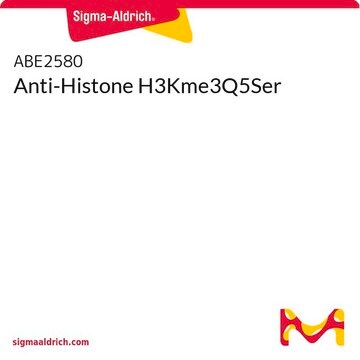V5764
Anti-Vesicular GABA Transporter antibody produced in rabbit
affinity isolated antibody, buffered aqueous solution
Synonyme(s) :
Anti-VGAT
About This Item
Produits recommandés
Source biologique
rabbit
Conjugué
unconjugated
Forme d'anticorps
affinity isolated antibody
Type de produit anticorps
primary antibodies
Clone
polyclonal
Forme
buffered aqueous solution
Puissance
2-4 mg per mL effective concentration (determined by immunoblotting, using mouse brain and rat brain extracts)
Poids mol.
antigen ~55 kDa
Espèces réactives
rat, mouse
Conditionnement
pkg of 200 μL
Conditions de stockage
avoid repeated freeze/thaw cycles (Storage in "frost-free" freezers is not recommended)
Concentration
~1.0 mg/mL
Technique(s)
microarray: suitable
western blot: 2-4 μg/mL using mouse brain and rat brain extracts (S1 fraction)
Numéro d'accès UniProt
Conditions d'expédition
dry ice
Température de stockage
−20°C
Modification post-traductionnelle de la cible
unmodified
Informations sur le gène
human ... SLC32A1(140679)
mouse ... Slc32a1(22348)
rat ... Slc32a1(83612)
Description générale
Immunogène
Application
- immunohistochemistry
- western blot
- immunocytochemistry
Immunohistochemistry (1 paper)
Actions biochimiques/physiologiques
Forme physique
Vous ne trouvez pas le bon produit ?
Essayez notre Outil de sélection de produits.
Faites votre choix parmi les versions les plus récentes :
Certificats d'analyse (COA)
Vous ne trouvez pas la bonne version ?
Si vous avez besoin d'une version particulière, vous pouvez rechercher un certificat spécifique par le numéro de lot.
Déjà en possession de ce produit ?
Retrouvez la documentation relative aux produits que vous avez récemment achetés dans la Bibliothèque de documents.
Notre équipe de scientifiques dispose d'une expérience dans tous les secteurs de la recherche, notamment en sciences de la vie, science des matériaux, synthèse chimique, chromatographie, analyse et dans de nombreux autres domaines..
Contacter notre Service technique






